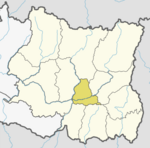Sangurigadhi Rural Municipality
Sangurigadhi
साँगुरीगढी गाउँपालिका | |
|---|---|
| Coordinates: 26°51′32″N 87°19′13″E / 26.858889°N 87.320278°E | |
| Province | Koshi Province |
| District | Dhankuta |
| Wards | 10 |
| Seat | Bhedetar |
| Government | |
| • Type | Village Council |
| • Chairperson | Mr. Jitendra Rai (NC) |
| • Vice-chairperson | Mrs. Muna Rai (CPN-UML) |
| Area | |
| • Total | 166.44 km2 (64.26 sq mi) |
| Population (2011) | |
| • Total | 21,536 |
| • Density | 130/km2 (340/sq mi) |
| Time zone | UTC+5:45 (Nepal Standard Time) |
| Website | official website |
Sangurigadhi (Nepali: साँगुरीगढी) is a rural municipality (gaunpalika) out of four rural municipality located in Dhankuta District of Koshi Province of Nepal. There are a total of 7 municipalities in Dhankuta in which 3 are urban and 4 are rural.
According to Ministry of Federal Affairs and Local Development Sangurigadhi has an area of 166.44 square kilometres (64.26 sq mi) and the total population of the municipality is 21536 as of Census of Nepal 2011.[1][2] To form this new Rural Municipality Budi Morang, Khuwaphok, Phaksib, Danda Bazar, Bhedetar, Mahabharat and Ahale were merged, which previously were all separate Village development committee (local level administrative villages).[3] Fulfilling the requirement of the new Constitution of Nepal 2015, Ministry of Federal Affairs and Local Development replaced all old VDCs and Municipalities into 753 new local level body (Municipality).
The Gaunpalika is divided into 10 wards and the Bhedetar is the headquarters of this newly formed rural municipality.
Demographics
[edit]At the time of the 2011 Nepal census, Sangurigadhi Rural Municipality had a population of 21,537. Of these, 31.0% spoke Bantawa, 28.0% Limbu, 12.2% Nepali, 7.8% Magar, 6.7% Yakkha, 5.4% Rai, 2.9% Tamang, 1.6% Yamphu, 1.0% Chintang, 0.8% Lohorung, 0.5% Maithili, 0.5% Newar, 0.2% Chamling, 0.1% Bote, 0.1% Gurung, 0.1% Tharu, 0.1% Wambule and 0.7% other languages as their first language.[4]
In terms of ethnicity/caste, 39.5% were Rai, 29.2% Limbu, 8.0% Magar, 6.7% Yakkha, 3.4% Chhetri, 3.1% Tamang, 2.2% Kami, 1.6% Yamphu, 1.4% Hill Brahmin, 1.2% Sarki, 0.8% Damai/Dholi, 0.6% Newar, 0.5% Majhi, 0.2% Gharti/Bhujel, 0.2% Gurung, 0.2% Tharu, 0.1% Bantawa, 0.1% Bengali, 0.1% Bote, 0.1% Kathabaniyan, 0.1% Teli, 0.1% Yadav and 0.8% others.[5]
In terms of religion, 67.2% were Kirati, 21.2% Hindu, 6.6% Buddhist, 4.7% Christian, 0.1% Muslim and 0.1% Prakriti and 0.2% others.[6]
In terms of literacy, 71.1% could read and write, 2.2% could only read and 26.7% could neither read nor write.[7]
References
[edit]- ^ "स्थानीय तहहरुको विवरण". www.mofald.gov.np/en. MoFALD. Retrieved 12 April 2018.
- ^ "CITY POPULATION – statistics, maps & charts". www.citypopulation.de. 8 October 2017. Retrieved 12 April 2018.
- ^ "गाउँपालिका संक्षिप्त परिचय" [Short Introduction of rural municipality]. www.sangurigadhimun.gov.np (in Nepali). Sangurigadhi Municipality. Retrieved 12 April 2018.
- ^ NepalMap Language [1]
- ^ NepalMap Caste [2]
- ^ NepalMap Religion [3]
- ^ NepalMap Literacy [4]
External links
[edit]



